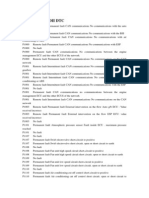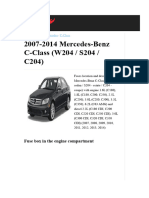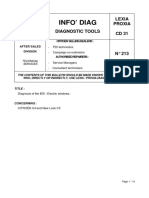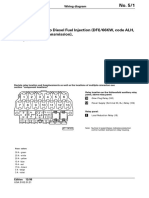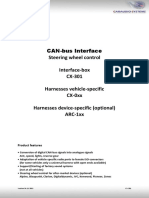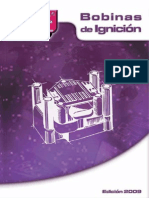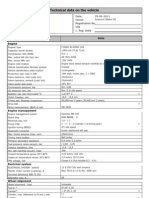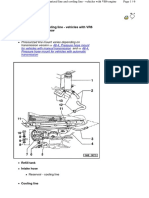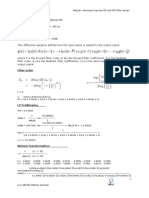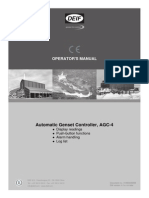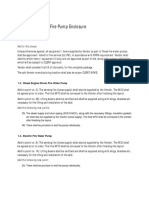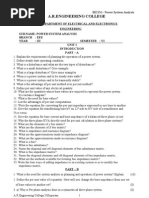Body Electrical System
Body Electrical System
Uploaded by
Leonardo Gómez BernigaCopyright:
Available Formats
Body Electrical System
Body Electrical System
Uploaded by
Leonardo Gómez BernigaCopyright
Available Formats
Share this document
Did you find this document useful?
Is this content inappropriate?
Copyright:
Available Formats
Body Electrical System
Body Electrical System
Uploaded by
Leonardo Gómez BernigaCopyright:
Available Formats
BODY
ELECTRICAL
SYSTEM
Return To Main Table of Contents
GENERAL .................................................................................. 2
FUSIBLE LINKS AND FUSES ................................................... 6
IGNITION SWITCH .................................................................... 7
INSTRUMENTS, GAUGES AND WARNING LAMPS.. ............. 8
MULTIFUNCTION SWITCH ........................................................ 16
LIGHTING SYSTEM.................................................................... 19
DAYTIME RUNNING LIGHT........................................................ 29
AUDIO .......................................................................................... 31
WINDSHIELD WIPER AND WASHER ..................................... 34
CLOCK AND CIGARETTE LIGHTER ...................................... 38
POWER WINDOW....................................................................... 39
POWER DOOR LOCK.................................................................. 43
POWER DOOR MIRROR............................................................. 44
HORN, FUEL FILLER AND TRUNK LID OPENER................. 46
SUN ROOF ................................................................................... 49
E.T.A.C.S..................................................................................... 51
AUTOMATIC TRANSAXLE AND KEY LOCK
CONTROL SYSTEM.................................................................... 56
PASSIVE SEAT BELT . . . . . . . . . . . . . . . . . . . . . . . . . . . . . . . . . . . . . . . . . . . . . . . . 59
90-2 GENERAL
GENERAL
SERVICING THE ELECTRICAL SYSTEM
1. When servicing the electrical system, disconnect the negative
cable from the terminal of the battery.
Caution
1. Before connecting or disconnecting the negative cable,
be sure to turn off the ignition switch and the lighting
switch.
(If this is not done, there is the possibility of
semiconductor parts being damaged.)
2. For MPI-equipped models, after completion of the work
steps [when the batterys negative (-) terminal is
connected], warm up the engine and allow it to idle
described below, in order to stabilize engine control
conditions, and then check to be sure that the idling is
satisfactory.
Engine coolant temperature : 80-95C (176-203F)
Lamps, electric fans, accessories: OFF
Transaxle: neutral position
(A/T models: N or P)
Steering wheel: neutral (center) position
2. If any section of a wiring harness interferes with the edge of a
part, or a corner, wrap the section of the harness with tape or
something similar in order to protect it from damage.
3. When installing any of the vehicle parts, be careful not to pinch
or damage any of the wiring harnesses.
4. If a burned-out fuse is to be replaced, be sure to use only a fuse
of the specified capacity. If a fuse a capacity larger than that
specified is used, parts may be damaged and the danger of fire
also exists.
GENERAL 90-3
5. The sensor, relay, etc, must never be subjected to strong
shocks. Do not allow them to fall and do not throw then when
handling.
6. The electronic parts used in the computer, relays, etc. are
readily damaged by heat. If there is a need for service opera-
tions that may cause the temperature to exceed 80C (176F),
remove the electronic parts beforehand.
7. Loose connectors could troubles. Make sure that the connec-
tors are connected securely.
8. When disconnecting a connector, be sure to pull only the
connector, not the harness.
9. Disconnect connectors which have catches by pressing in the
direction indicated by the arrows in the illustration.
90-4 GENERAL
10. Connect connectors which have catches by inserting the
connectors until a click noise is heard.
11. When using a circuit tester to perform continuity or voltage
checks on connector terminals, insert the test probe from the
harness side.
If the connector is a sealed connector, insert the test probe in
through the hole in the rubber cap for the electrical wires, being
careful not to damage the insulation of the wires continue to
insert the test probe until it contacts the terminal.
CHECKING CABLES AND WIRES
1. Checking the terminal for tightness.
2. Check terminals and wires for corrosion by battery electrolyte,
etc.
3. Check terminals and wires for open circuit or impending open
circuit.
4. Check wire insulation and coating for damage, cracks and
degrading.
5. Check conductive parts of terminals for contact with other
metallic parts
(vehicle body and other parts).
6. Check grounding parts to verify that there is complete continuity
between attaching bolt(s) and vehicle body.
7. Check for incorrect wiring.
8. Check that wirings are so clamped as to prevent contact with
sharp corners of the vehicle body, etc. or hot parts (exhaust
manifold, pipe, etc.)
9. Check that wirings are clamped firmly to secure enough
clearance from the fan pulley, fan belt and other rotating or
moving parts.
10. Check that the wirings between the fixed parts such as the
vehicle body and the vibrating parts such as the engine are
made with adequate allowance for vibrations.
CHECKING FUSES
A blade type fuse has test taps provided to allow checking of the
fuse itself without removing it from the fuse block. The fuse is okay
if the test lamp comes on when its one lead is connected to the test
taps (one at a time) and the other lead is grounded. (Change the
ignition switch position adequately so that the fuse circuit becomes
live.)
GENERAL
90-5
INSTALLATION OF RADIO EQUIPMENT
The computers of the electronic control system has been designed
so that external radio waves will not interfere with their operation.
However, if the antenna or cable of the amateur transceiver etc. is
routed near the computers, it may affect the operation of the
computers, even if the output of the transceiver is no more than
25W.
To protect each of the computers from interference by transmitter
(hum, transceiver, etc.) the following should be observed.
1.
2.
3.
4.
5.
Install the antenna on the roof or rear bumper.
Because radio waves are emitted from the coaxial cable of the
antenna, keep it 200 mm (8 in.) away from the computers and
the wiring harness. If the cable must cross the wiring harness,
route it so that it runs at right angles to the wiring harness.
The antenna and the cable should be well matched, and the
standing-wave ratio* should be kept low.
A transmitter having a large output should not be installed in the
vehicle.
After installation of transmitter, run the engine at idle, emit radio
waves from the transmitter and make sure that the engine is not
affected.
*STANDING-WAVE RATIO
If an antenna and a cable having different impedances are connected,
the input impedance Zi will vary in accordance with the length of the
cable and the frequency of the transmitter, and the voltage distri-
bution will also vary in accordance with the location.
The ratio between this maximum voltage and minimum voltage is
called the standing-wave ratio. It can also be represented by the
ratio between the impedances of the antenna and the cable.
The amount of radio waves emitted from the cable increases as the
standing-wave ratio increases, and this increases the possibility of
the electronic components being adversely affected.
90-6 FUSIBLE LINKS AND FUSES
FUSIBLE LINKS AND FUSES
FUSIBLE LINK
Specifications
Items Specifications
Main fusible link
Sub. fusible link
(Located in engine
compartment relay box)
Rated capacity Circuit
Type
Housing color
60A
20A
Charging
Cooling
Screw-up
Screw-up
Yellow
Blue
Circuit
Item
P/WDW H/LAMP
BATT ECI RAD IGN SW ABS
Rated
capacity
30A 30A 50A 20A 30A 30A 40A
Housing
Pink Pink Red Blue Pink Pink Green
color
Type
Connector type
Inspection
1. Check for a burnt fusible link with an ohmmeter.
2. If a fusible link burns out, there is a short or some other problem
in the circuit.
Carefully determine the cause and correct it before replacing
the fusible link.
NOTE
The fusible link will burnt out within 15 seconds if a higher than
specified current flows through the circuit.
FUSES
Inspection
1. Be sure there is no play in the fuse holders, and that the holders
hold the fuses securely.
2. Are fuse capacities for each circuit correct ?
3. Are there any blown fuse?
If a fuse is to be replaced, be sure to use a new fuse of the
specified capacity. Always determine why the fuse blew first
and completely eliminate the problem before installing a new
fuse.
CAUTION
Never use a fuse of higher capacity than specified.
IGNITION SWITCH
IGNITION SWITCH
INSPECTION
1. Separate the connector located under the steering column.
2. Inspect the switch continuity between the terminals.
3. If continuity is not as specified, replace the switch.
NOTE
O-0 indications that there is continuity between the terminal.
RO : Round the locking bar
RE : Return the locking bar
L : Lock
F : Free
INSTRUMENTS, GAUGES AND WARNING LAMPS
INSTRUMENTS, GAUGES AND WARNING LAMPS
INSTRUMENT CLUSTER
SPECIFICATIONS OF INDICATOR AND WARNING LAMPS
Items
Indicator lamps
Direction indicator (LH/RH)
Battery charging
Oil pressure
Brake failure
Door warning
Rear window defogger
Check engine
High beam
Low washer (Canada)
Low fuel
Safety belt
ABS warning
SERVICE STANDARD
Specification (wattage) Items Specification (wattage)
Trunk lid ajar
Illumination lamps
A/T position indication
P
R
N
D
L
OD OFF
1.2 W
3.4 W
1.2 W
1.2 W
1.2 W
1.2 W
1.2 W
1.2 W
INSTRUMENTS, GAUGES AND WARNING LAMPS 90-9
Fuel sender
Water temperature gauge
Water temperature sender
Voltage gauge
Oil pressure gauge
Oil pressure sender
TIGHTENING TORQUE
Float position
Resistance (Q)
Allowable error (Q)
Temperature (C)
Angle
Tolerance
Temperature (C)
Resistance (Q)
Voltage (V)
Angle
Allowable error (V)
Pressure (Kg/cm
2
)
Angle
Resistance (Q)
Pressure (Kg/cm
2
)
Resistance (Q)
F 1.2 E
3 32.5 110
2 4 7
60 85 110 125
-30 -7 -7 +30
+ 2 + 2
- 3 - 3
1.5
60 85 110 125
128 49.5 24.9 14.8
8 10 12 14 16
-30 -16 0 16 30
0.5 0.5 0.6
0.3
2.7
7 10
-32.5
-21.5
16 32.5
3 4
0.3 2.7 7 10
310 25 195 16 49 12 20 8
Items
Coolant temperature sender
Oil sender pressure
Oil switch pressure
Nm
10-12
8-12
8-12
Specifications
Kg.cm
100-200
80-120
80-120
Ib.ft
7-9
6-9
6-9
90-10
INSTRUMENTS, GAUGES AND WARNING LAMPS
COMPONENTS
INSTRUMENTS, GAUGES AND WARNING LAMPS 90-11
PRINTED CIRCUIT BOARD
CIRCUIT DIAGRAM
90-12
INSTRUMENTS, GAUGES AND WARNING LAMPS
COMPONENT CHECK
Speedometer
1. Using a speedometer tester, inspect the speedometer for
allowable indicating error and check the operation of the
odometer.
NOTE
Tire wear and tire over or under inflation will increase the
indication error.
2. Check the speedometer for pointer vibration and abnormal
noises.
NOTE
Pointer vibration can be caused by a loose or dry
speedometer cable.
Speedometer cable
Insert the cable until the stopper properly fits into the speedometer
groove.
CAUTION
Poor installation of the cable may cause a fluctuating pointer,
noise and a damaged harness inside the instrument panel.
Tachometer
1. Connect a tachometer and start the engine.
2. Compare the tester and tachometer indications.
If the difference is excessive, replace the tachometer.
CAUTION
1) Reversing the connections of the tachometer will
damage the transistor and diodes.
2) When removing or installing the tachometer, be careful
not to drop it or subject it to severe shock.
INSTRUMENTS, GAUGES AND WARNING LAMPS
90-13
Fuel gauge
1. Lift up the vehicle and disconnect the connector of the fuel
gauge from the fuel sender .2. Ground to the harness side
connector via (terminals 3) the 12V, 3.4W bulb.
3. Turn the ignition key to the ON position.
4. Check to be sure that the test bulb flashes and that the indicator
moves.
Fuel sender resistance
1. Measure (with the float as the F position and at the E
position) the resistance between ground and the sender terminal
for the fuel gauge.
Standard specification : Point F :
3 2
Point E : 110-17R
2. Also check that the resistance changes smoothly when the float
is moved to F and E.
Fuel level sensor
1. Connect the sender with a test lamp (12V, 3.4W) to the battery
and immerse it in water.
2. The lamp should be off while the thermistor is beneath the
water, and should illuminate when the sender is taken out of the
water.
NOTE
If there is a malfunction, replace the fuel sender as an
assembly.
CAUTION
After completing this test, wipe the sender dry and
install it in the fuel tank.
WATER TEMPERATURE GAUGE
1. Disconnect the wiring connector from the water temperature
sender in the engine compartment.
2. Ground to the harness side connector via the 12V, 2.3W bulb.
3. Turn the ignition key to the ON position.
4. Check to be sure that the test bulb flashes and that the indicator
moves.
90-14 INSTRUMENTS, GAUGES AND WARNING LAMPS
Water temperature sender
1. Using an ohmmeter, measure the resistance between the
terminal and ground.
2. If the resistance value is not as shown in the table below,
replace the temperature sender.
Temperature C (F) 60 (140) 110 (230)
Resi st ance Sz 125
24
Oil pressure sender
1. Check the engine oil level. Add oil if insufficient, or replace it if
the connection is bad.
2. Measure the resistance changes by connecting an ohmmeter
between a good ground (vehicle body) and the terminal of the
sender.
3. Refer to service standard.
Oil pressure switch
Specifications
Type
Contact points
Lighting oil pressure
0.3 kg/cm
2
(4.27 psi)
If operation is not as specified, replace the oil pressure switch.
Voltage gauge
1. Connect the voltmeter in parallel with the volt gauge.
2. The voltmeter indication should be equal to the volt gauge.
Voltage (V)
8 10 12 14 16
Allowable error (V) - 0.5 0.5 -
0.6
Brake warning lamp and switch
The brake fluid level sensor or the parking brake switch is switched
ON, and the brake warning lamp illuminates, when, with the ignition
switch at the ON position, the brake fluid level is at or below the
specified level, or the parking brake lever is pulled.
NOTE
The brake fluid level sensor is built into the master cylinder
reservoir cap.
INSTRUMENTS, GAUGES AND WARNING LAMPS 90-15
Parking brake switch
The parking brake switch is a push type and located under the
parking brake lever. To adjust, move the switch mount up and down
with the parking brake lever released all the way.
Door switch
Remove the door switch and check for continuity between the
terminals.
If continuity is not as specified, replace the door switch
90-16 MULTIFUNCTION SWITCH
MULTIFUNCTION SWITCH
COMPONENTS
M05-1 M05-2
REMOVAL AND INSTALLATION
1. Remove the steering wheel.
2. Remove the steering column lower and upper shroud.
MULTIFUNCTION SWITCH
3. Remove the multifunction switch mounting screws.
4. Disconnect the harness connector.
CAUTION
Make sure the wire leads are not being pulled when you
move the lever.
Check that lever works freely without binding.
5. Installation is the reverse order of removal.
OPERATION CHECK
Check the continuity between the terminals while operating the
switch.
Lighting switch (M05-1/*M05-2)
Dimmer and passing switch (M05-1)
Turn signal switch (M05-1)
Wiper and washer switch (M05-2)
MULTIFUNCTION SWITCH
Automatic speed control (cruise) switch (M05-2)
LIGHTING SYSTEM 90-19
LIGHTING SYSTEM
SPECIFICATIONS North America Australia
Head lamp
Front combination lamps
Turn signal lamp
Front position lamp
Rear combination lamps (outside)
Turn signal lamp
Stop and tail lamp
Rear combination lamps (inside)
Stop(Fog, Australia only) and tail lamp
Back-up lamp
Interior lamps
Luggage and glove box lamp
Room lamp
Door lamp
High mounted stop lamp
Licence plate lamp
Flasher unit
Turn signal blinking frequency
Hazard warning blinking frequency
60/45 W
28/8 W
5 W
27 W
27/8 W
27/8 W
27 W
5 W
10 W
5 W
17 W
8 W
85 10 C/M at 12.8 V
80 12 C/M at 12.8 V
60/55 W
21 W
4 W
21 W
21/5 W
21/ -w
21 W
5 W
10 W
5 W
17 W
5 W
90-20 LIGHTING SYSTEM
HEAD LAMP AIMING
Pre-aiming instructions
1. Test dimmer switch operation.
2. Observe operation of high beam indicator lamp mounted in the
instrument cluster.
3. Inspect for badly rusted of faulty head lamp assemblies.
These conditions should be corrected before a satisfactory
adjustment can be made.
4. Place the vehicle on a level floor.
5. Bounce the front suspension through three (3) oscillations by
applying body weight to the bumper.
6. Check and correct tire inflation pressures.
7. Rock vehicle sideways to allow vehicle to assume its normal
position.
8. If the fuel tank is not full, place a weight in the trunk of the vehicle
to simulate the weight of a full tank.
9. There should be no other load in the vehicle other than that of
the driver or substituted weight of approximately 75 kg (165
Ibs.) placed in the drivers position.
10. Thoroughly clean the head lamp lenses.
Compensating the aimers for floor slope
The floor level offset dial must coincide with the floor slope for
accurate aiming. Calibration fixtures are included with the aimers.
1.
2.
3.
4.
5.
6.
Attach one calibration fixture to each aimer. Fixtures will easily
snap into position on the aimer when properly positioned.
Place the aimers at the center line of each wheel on one side
of the vehicle. Unit A must be placed at the rear wheel with the
target facing forward. Unit B must be placed at the front wheel
with the target facing rearward.
Adjust the thumb screw on each calibration fixture by turning
either clockwise or counter-clockwise until the level vial bubble
registers in a centered, level position.
Look into the top port hole of Unit A. Turn the horizontal knob
until the split image is aligned.
Transfer the plus or minus reading indicated on the horizontal
dial to the floor level offset dial on each aimer.
Press the floor level dial inward to set reading.
Remove the calibration fixtures from both units.
LIGHTING SYSTEM 90-21
Testing aimer calibration
The aimer calibration may be off due to extended use.
Calibration fixtures used in conjunction with the aimers can be
used to check and adjust the aimer.
Turn the thumb adjusting screw on each calibration fixture until
it is approximately the same distance as the supporting posts.
Attach the calibration fixtures to each unit with the level vials on
1.
2.
3.
top.
4.
5.
6.
Locate a true vertical plate glass window or smooth surface and
position the aimers three to five feet apart so that the split image
targets can be located in the viewing ports.
Set the floor level dial to zero.
Rotate the thumb adjusting screws on each calibration fixture
until the level vials on the fixtures are centered.
With both calibration level vials centered, turn the vertical dial
knobs on each aimer until the aimer level vials are centered. If
the aimer vertical dial pointers read between 1/2 up and 1/2 down,
the aimers are within allowable vertical tolerance, Recalibrate
the units if they are beyond these limits.
Vertical dial pointer reading (on each aimer) . . . . . . . . . . . . . . . . . . . . .
1/2 up to 1/2 down
7. Adjust the horizontal dial knob on each aimer until the split
image targets align. If the aimer horizontal dial pointers read
between 1 left and 1 right, the aimers are within allowable
tolerance limits. Recalibrate the units if beyond these limits.
Horizontal dial pointer reading (on each aimer) . . . . . . . . . . . . . . . . . .
1 left to 1 right
Mounting aimers
1. Remove the calibration fixture from the each unit.
2. As shown in the figure, install the articulating vacuum cup
assembly (A), vacuum extension plate (B) and small universal
adaptor (C) to each unit.
90-22 LIGHTING SYSTEM
3. Make the length of the adjustable rod as shown in the figure.
4. Position the aimers on the head lamps pushing the piston
handle forward, engaging the rubber suction cup. Immediately
pull back the piston handle until it is locked in place.
NOTE
Steel inserts are molded into position on the adaptor to
insure accuracy. These inserts should be in contact with
the three guide points on the lamps when the aimers are
properly positioned.
Horizontal adjustment
1. Set the horizontal dial to zero.
2. Check to see that the split image target lines are visible in the
viewing port. If necessary, rotate each aimer slightly to locate
the target.
3. Turn the horizontal screw on the side of the head lamp until the
split image of target line appears in the mirrors as one solid line.
To remove backlash, make the final adjustment by turning
adjusting screw in a clockwise direction.
4. Repeat the last three steps on the apposite head lamp.
Vertical adjustment
1. The vertical dial should be set a zero. (For passenger vehicles,
0 setting is generally required. For special settings, consult
local state laws.)
2. Turn the vertical adjusting screw until the level bubble is
centered between the lines.
3. Repeat the last two steps on the opposite head lamp.
4. Re-check the target alignment on both aimers and readjust the
horizontal aimer if necessary.
5. Remove the aimers by pressing Vacuum release button
located on the piston handle.
LIGHTING SYSTEM 90-23
Aiming with screen
Head lamp aiming preparation
Place the vehicle on a level floor 7.6 m (25 feet) apart from the
aiming screen or a light-colored wall. Four lines of adhesive tape
are required on the screen or wall:
1. Position a vertical piece of tape so that it is aligned with the
vehicle center line.
2. Position a horizontal piece of tape with reference to the center
line of the head lamp.
3. Position a vertical piece of tape on the screen for vertical
adjustment, adjust the side screw for horizontal adjustment.
Visual head lamp adjustment
1. A properly aimed low beam will appear on the aiming screen
7.6m (25 feet) in front of the vehicle. The shaded area as shown
in the illustration indicates a high intensity zone.
2. Adjust the low beam head lamps to match the low beam pattern
of the right and left head lamps.
NOTE
If the visual head lamp adjustment at low beam is made, the
adjustment at high beam is not necessary.
REPLACEMENT OF LAMPS
Head lamp/Front position lamp
1. Disconnect the battery negative terminal.
2. After loosening the nut, pull out the front combination lamp (turn
signal lamp incorporated)
Tightening torque of front combination lamp mounting nut
. . . . . . . . . . . . . . . . . . . . . . . . 0.5-1.0 Nm (5-10 kg.cm, 0.4-0.7 Ib.ft)
3. Remove the radiator grille.
Tightening torque of radiator grille mounting screw
. . . . . . . . . . . . . . . . . . . . . . 0.5-1.0 Nm (5-10 kg.cm, 0.4-0.7 Ib.ft)
Verti cal center l i ne ahead of l ef t headl i ght
Hi gh i ntensi ty area
Vehi cl e axi s
Verti cal center l i ne ahead of ri ght headl i ght
Hei ght of l i ght centers
Hi gh i ntensi ty area
LIGHTING SYSTEM
4. Remove the headlamp assembly with transverse filler by
loosening the 4 mounting bolts.
5. Disconnect the headlamp connector.
6. Disconnect the transverse filler from headlamp assembly.
7. Installation is the reverse order of removal.
Tightening torque of headlamp mounting bolt
. . . . . . . . . . . . . . . . . . . . . . . . . . . . . . . . 3-5 Nm (30-50 kg.cm, 2.2-3.6 Ib.ft)
Outside rear combination lamp
1. Disconnect the negative terminal from the battery.
2. Open the trunk lid.
3. With rear luggage cover opened, loosen the 4 mounting nuts.
Tightening torque of rear combination (outside)
lamp-mounting nut
. . . . . . . . . . . . . . . . . . . . . . . . 2.0-25Nm (20-25 kg.cm, 1.5-1.8 Ib.ft)
4. After disconnecting the connector, remove the lamp assembly.
5. Installation is the reverse order of removal.
Inside rear combination lamp
1. Disconnect the negative terminal from the battery.
2. Remove the inside rear combination lamp cover.
3. Remove the inside rear combination mounting nuts.
Tightening torque of rear combination (inside)
lamp mounting nut
. . . . . . . . . . . . . . . . . . . . . . . . . . 2.0-2.5 Nm (20-25 kg.cm, 1.5-1.8 Ib.ft)
LIGHTING SYSTEM 90-25
4. After-disconnecting the connector, remove the lamp assembly.
5. Installation is the reverse order of removel.
High Mounted Stop Lamp
1. Disconnect the battery negative terminal.
2. Using a screw driver, detach 2 blanking covers on both sides of
the lamp.
3. Loosening the mounting screws.
4. Remove the lamp assembly from the rear package tray trim
5. Disconnect the connector from harness.
6. Installation is the reverse order of removal.
Overhead Console Lamp (Vehicles with sunroof)
1. Disconnect the battery negative terminal.
2. Using a screw driver, detach the overhead console lamp lens.
3. Remove the lamp assembly from the head lining by loosening
2 screws.
4. Disconnect the connector from the roof harness.
5. Installation is the reverse order of removal.
90-26
LIGHTING SYSTEM
Door lamp
1. Disconnect the battery negative terminal.
2. Remove the door lamp while inserting the screw driver.
3. Disconnect the connector from door harness.
4. Installation is the reverse order of removal.
INSPECTION OF COMPONENTS
Relay
1. Remove the head lamp and taillamp relay from engine
compartment relay box.
2. Check for continuity between the terminals.
NOTE
1. M indicates that there is a continuity between the
terminals.
2. -0 indicates power supply connection.
Flasher unit
1. Remove the flasher unit from the relay box in passenger
compartment.
2. Connect the positive (+) lead from the battery to terminal 3 and
the negative (-) lead to terminal 2.
3. Connect the two turn signal lamps parallel to each other to
terminal 1 and 2, check that the bulbs turn on and off.
NOTE
The turn signal lamps should flash 60 to 120 times per
minute.
If one of the front or rear turn signal lamps has an open
circuit, the number of flashes will be more than 120 per
minute.
If the operation is not as specified, replace the flasher unit.
LIGHTING SYSTEM
Hazard switch
1. Disconnect the battery negative terminal.
2. Remove the hazard switch from the cluster facia panel RH side.
3. Disconnect the connector from the instrument harness.
4. Operate the switch and check for continuity between terminals
by using an ohmmeter.
Rheostat
1. Disconnect the battery negative terminal.
2. Remove the rheostat from crash pad side panel.
3. Disconnect the connector from instrument harness.
4. Check for intensity
If the light intensity of the lamps changes smoothly without any
flickering when the rheostat is turned, it can be assumed that
the rheostat is functioning properly.
Luggage compartment lamp switch
1. Disconnect the battery negative terminal.
2. Remove the luggage compartment lamp switch from the trunk
lid striker.
3. Disconnect the connector from rear harness.
90-28 LIGHTING SYSTEM
4. Check for continuity between terminal and body while pushing
the rod.
Switch rod condition Continuity
Pushed (OFF)
Non-conductive (- Q)
Released (ON)
Conductive (0 Q)
DAYTIME RUNNING LIGHT 90-29
DAYTIME RUNNING LIGHT (DRL)
DAYTIME RUNNING LIGHT
OPERATION CHECK
Check that the lights are normally operated with following timing
chart.
Timing chart
AUDIO
AUDIO
REMOVAL AND INSTALLATION
Radio unit
1. Remove the center lower crash pad facia panel.
2. Remove the radio unit from the lower crash pad main assembly
by loosening the mounting screws.
3. Disconnect the connector and antenna receptacle from main
harness and antenna feed wire.
4. Installation is the reverse order of removal.
Front speaker
1. Detach the speaker grille.
2. Remove the speaker mounting bolts.
3. Remove the speaker assembly.
4. Installation is the reverse order of removal.
Rear speaker
1. Remove the speaker mounting nuts.
2. Disconnect the wiring connector.
3. Replace in reverse order of the preceding steps.
Automatic antenna
1. Remove the luggage side trim.
90-32
2. Remove the antenna mounting nuts and tapping screw
for ground.
3. Disconnect the wiring connector and antenna cable.
4. Remove the antenna assembly.
5. Replace in reverse order of the preceding steps.
SERVICE INSTRUCTIONS
Fuse replacement
Be sure to use a specified fuse when replacing a in-line fuse, for
radio unit.
Radio unit grade Fuse ratings
Base model 1A&3A
Others 3A & 5A
CAUTION
Substituting with a higher capacity fuse or connecting without
a fuse may result in damage to the unit.
Tape head and capstan cleaning
1. To obtain optimum performance, clean the head and capstan
as often as necessary, depending upon frequency of use and
tape cleanness.
2. To clean the tape head and capstan, use a cotton swab dipped
in ordinary rubbing alcohol.
Wipe the head and capstan.
Speaker checking
1. Check the speaker by using an ohmmeter
If an ohmmeter indicates the impedance of the speaker when
checking between the speaker (+) and speaker (-) of the same
channel, the speaker is okay.
2. If clicking sound is emitted from the speaker when the
ohmmeter plugs touch the speaker terminals, the speaker is
okay.
Automatic antenna inspection
AUDIO
90-33
Connect the motor terminals directly to the battery and check that
the motor operates smoothly. Next, reverse the polarity and check
that the motor operates smoothly in the reverse direction.
90-34 WINDSHIELD WIPER AND WASHER
WINDSHIELD WIPER AND WASHER
SPECIFICATIONS
Item
Wiper motor
10 kg.cm load speed/current
Low
High
40 kg.cm load speed/current
Low
High
Wiper blade
Wiping angle
Drivers/passengers side
Wiper blade length
Drivers/passengers side
Windshield washer
Motor type
Pump type
Rated current
Flow rate
Over load capacity (continuous operation)
With water
Without water
Specification
48-56 rpm/ Max. 3.5 A
64-78 rpm/ Max. 4.5 A
40-48 rpm/ Max. 5.5 A
56-68 rpm/ Max. 7.0 A
87.2/100
500 mm/456 mm
DC ferrite magnet type
Centrifugal type
Max. 3.8 A
Min. 1320 cc/min.
Max. 60 sec.
Max. 20 sec.
TIGHTENING TORQUE
Nm kg.cm Ib.ft
Wiper motor mounting bolt 7-11 70-110 5.06-7.96
Wiper arm mounting nut 18-22 180-220 13.02-15.91
Wiper linkage mounting bolt 4-6 40-60 2.89-4.34
WINDSHIELD WIPER AND WASHER
90-35
COMPONENTS
Windshield Wiper
Ai r i nl et garni sh
Windshield Washer
90-36 WINDSHIELD WIPER AND WASHER
SERVICE POINT OF REMOVAL
Front deck panel
Remove the mounting screws and pry up the front deck panel and
remove it.
Air inlet cover
Remove the air inlet cover while pressing the tab.
Wiper motor
1. Loosen the wiper motor assembly mounting bolts, and then
remove the wiper motor assembly.
2. Disconnect the wiper motor from linkage and the motor
assembly, and then remove the linkage.
CAUTION
Because the installation angle of the crank arm and the
motor has been set, do not remove them unless it is
necessary to do so. If they should be removed, remove
them only after marking their mounting positions.
Wiper, blade
1. Pull out the rubber and backing blade from the stopper side.
2. Remove the backing blade from the rubber.
SERVICE POINT OF INSTALLATION
Wiper arm
Mount the wiper arms onto the pivot shaft so that the stopping
position of the wiper blades is in agreement with the standard
specifications.
Standard specifications (distance between the blade tip and
the front deck panel) : 30 3 mm (1.2 0.12 in.)
WINDSHIELD WIPER AND WASHER 90-37
INSPECTION OF COMPONENTS
Wiper motor speed operation
1. Remove the connector from the wiper motor.
2. Attach the positive (+) lead from the battery to terminal 1 and the
negative (-) lead to terminal 5.
3. Check that the motor operates at low speed.
4. Connect the positive (+) lead from the battery to terminal 1 and
the negative (-) lead to terminal 6.
5. Check that the motor operates at high speed.
Wiper motor automatic stop operation
1. Operate the motor at low speed.
2. Stop the motor operation anywhere except at the off position
by disconnecting terminal 5.
3. Connect terminals 5 and 2.
4. Attach the positive (+) lead from the battery to terminal 1.
5. Check that the motor stops running at the off position.
Washer motor operation
1. With the washer motor connected to the washer tank, fill the
washer tank with water.
2. Connect battery positive (+) and negative (-) cables to terminals
2 and 1 respectively to see that the washer motor runs and
water is pumped.
Washer fluid contact point
1. Check the washer fluid contact point.
2. Adjust the washer fluid contact point by using a metal wire to
move the washer nozzle ball.
3. If the amount of washer fluid sprayed is too small, check for
clogged, bent or crushed washer tube.
90-38 CLOCK AND CIGARETTE LIGHTER
CLOCK AND CIGARETTE LIGHTER
SPECIFICATIONS
Item
Specification
Clock
Time accuracy
Current consumption
Cigarette lighter
Maximum input
Return time
Break temperature of thermal fuse
Within 2 sec/day (at DC 13V)
Max. 150 mA (at DC 13V)
120 W
13 5 sec (after pushing the lighter in)
138-151C (278.4-303.4F)
REPLACEMENT OF CLOCK
1. Remove the 4 screws and pull out the cluster.
2. Disconnect the wiring connector.
3. Remove the digital clock assembly by unscrewing the 2 screws.
CAUTION
The clock is composed of delicate electronic components
containing a crystal oscillator, transistor, etc. and should
be handled with care. Specialized technical skill is needed
to repair the internal mechanism of this clock. Do not
attempt to disassemble it. If the clock itself is
malfunctioning, replace the entire assembly.
INSPECTION OF CIGARETTE LIGHTER
1. Take out the plug.
2. Examine the element spot connection for remnants of tobacco
and other materials.
3. Using an ohmmeter, check for the continuity of the element.
Cautions for use of the cigarette lighter socket as auxiliary
power.
1. When using a plug-in type of accessory, do not use anything
with a load of more than 120W.
2. It is recommended that only the lighter be inserted into the
holder.
POWER WINDOW
POWER WINDOW
REPLACEMENT OF POWER WINDOW MOTOR
Removal
1. Using a screwdriver, remove the clip shown in the illustration to
remove the regulator handle. (Manual type only)
2. Remove the quadrant inner cover.
3. Remove the rearview mirror mounting screws and then remove
the rear view mirror.
Disconnect the remote control connector. (Electric type only)
9 0 - 4 0 POWER WINDOW
4. Remove the safety lock knob.
Remove the screws from the inside handle bezel and arm rest
5. Insert a screwdriver between the trim fasteners and door panel
to pry it loose.
Disconnect the connectors. (Power Window Motor, Power
Window Main Switch, Door Lock Actuator, Outside Mirror and
Trunk Lid Opener Switch)
6. Remove the door trim seal.
7. Detach the regulator assembly.
8. Disconnect the power window motor from the regulator
assembly.
CAUTION
When loosening the mounting screws of the regulator and
the motor assembly, the compressed force of the regulator
spring may cause the regulator arm to spring up.
Installation
Installation is the reverse order of removal.
CAUTION
When installing the door trim seal, butyl tape should not be
placed over door trim fastener mounting area.
POWER WINDOW
INSPECTION OF COMPONENTS
Power window regulator motor
Connect the motor terminals directly to the battery and check that
the motor operates smoothly. Next, reverse the polarity and check
that the motor operates smoothly in the reverse direction. If the
operation is abnormal, replace the motor.
Power window relay
Check for continuity between the terminals 2 and 4.
While power is not supplied : No continuity
While power is supplied : Continuity
Power window main switch
1. Disconnect the power window main switch.
2. Operate the switch, and check for continuity between the
terminals.
3. If continuity is not as specified, replace the switch.
Window lock switch
POWER WINDOW
Power window sub-switch
1. Operate the switch, and check for the continuity between the
terminals.
2. If continuity is not as specified, replace the switch.
POWER DOOR LOCK
POWER DOOR LOCK
INSPECTION OF COMPONENTS
Door lock control actuator
1. Disconnect the actuator connector from the wiring harness.
2. Apply battery voltage (DC 12 V) to each terminal as shown in
the table below and confirm that the actuator makes
corresponding operation.
Door lock control relay
1. After tracing the problem to the control relay, replace it with a
new one. Check for proper operation.
2. If system operates properly, the original control relay is faulty.
90-44
POWER DOOR MIRROR
POWER DOOR MIIRROR
COMPONENTS
INSPECTION OF COMPONENTS
Mirror switch
1. Remove the outside mirror switch on the rear console.
2. Disconnect the connector from the harness.
3. Operate the switch and check for continuity between the
terminals. If continuity is not as specified, replace the mirror
switch.
POWER DOOR MIRROR 90-45
Mirror actuator
Apply battery voltage to each terminal as shown in the table and
confirm that the mirror operates properly.
90-46 HORN, FUEL FILLER DOOR AND TRUNK LID OPENER
HORN, FUEL FILLER DOOR AND TRUNK LID OPENER
SPECIFICATIONS
Item
Horn
Type
Current consumption
Sound level
Basic frequency
Low pitch
High pitch
Fuel filler door opener
Exciting current
Trunk lid opener
Current consumption
Circuit breaker
Trip time
Recovery time
HORN
Removal and installation
1. Disconnect the negative cable of the battery.
2. Remove the horn attaching bolt (on the radiator support panel).
3. Disconnect the horn connector from engine harness.
4. Remove the horn.
Specification
Plate type
Max. 3.5 A (at DC 12V)
105 5 dB (at DC 12V, 2m)
360 20 Hz (at DC 12V)
420 20 Hz (at DC 12V)
Max. 15A (at DC 12V)
Max. 12A (at DC 12V)
4-9 sec.
5 sec
Sound level adjustment
Operate the horn, and adjust the tone to a suitable level (by
turning the adjusting screw).
CAUTION
After the adjustment, apply a small amount paint around the
screw head to keep it from loosening.
HORN, FUEL FILLER DOOR AND TRUNK LID OPENER 90-47
FUEL FILLER DOOR OPENER
COMPONENTS
INSPECTION OF COMPONENTS
Fuel filler door opener
1. Remove the luggage compartment side trim.
2. Open the fuel filler door.
3. Loosen the three bolts securing the fuel filler door opener and
then disconnect the wiring connector.
4. Check for continuity between terminals 1 and 2. If there is no
continuity, replace the fuel filler door opener.
Fuel filler door opener switch
Operate the switch, and check for continuity between the terminals.
If continuity is not as specified, replace the switch.
90-48 HORN, FUEL FILLER DOOR AND TRUNK LID OPENER
TRUNK LID OPENER
COMPONENTS
INSPECTION OF COMPONENTS
Trunk lid opener
1. Remove the trunk lid opener and check continuity between the
terminal a and b.
2. If there is no continuity, replace the opener assembly.
Trunk lid opener switch
Remove the trunk lid opener switch and check continuity between
the terminals.
SUN ROOF
SUN ROOF
SPECIFICATIONS
Item
Sun roof motor
No load speed/current
Lock current
Sun roof relay
Rated load
Exciting current
Sun roof motor switch
Type of operation
Rated load
INSPECTION OF COMPONENTS
Sun roof motor
1. Remove the overhead console lamp.
2. Disconnect the motor connector from sun roof harness.
3. Apply DC 12V to the 0.85 YR wire and ground the 0.85Y wire.
4. Check that the motor turns in the direction to tilt up and closed
position,
5. Reverse the connections and check that the motor turns from
open, to closed, to tilt up position.
Specification
Max. 180 rpm/Max. 6 A
Max. 35 A
Motor 6 A/Lock 15 A
Max. 250 mA
Push on and self-return
1 A
SUN ROOF
Sun roof relay
Check for continuity between the terminals.
Sun roof switch
1. Using an ohmmeter, check for continuity between terminals.
2. If the continuity is not as specified, replace the switch.
E.T.A.C.S. 90-51
E.T.A.C.S. (Electronic Time and Alarm Control System)
SPECIFICATIONS
ETACS unit
Rated load
Variable intermittent wiper
Rear defogger timer
Seat belt warning
Key illumination & delay out room lamp
Door lock actuator (lock, unlock)
Chime bell
Leakage current
Rear window defogger glass
Power consumption
DC 12V, 6A (Inductive load)
DC 12V, 200 mA (Inductive load)
DC 12V, 1.2W (Lamp load)
DC 12V, 1.2W, 10W (Lamp load)
DC 12V, 200 mA (Inductive load)
DC 13.5V, 350 mA (inductive load)
Max. 4 mA (at 12.8V)
185 10 W (Per sheet)
COMPONENTS
90-52
E.T.A.C.S.
OPERATION CHECK OF COMPONENTS
While operating the components, check whether the operations are
normal with timing chart.
Variable intermittent wiper
1. Time specification
T 1 : Max. 0.5 sec.
T 2 : Time of wiper motor 1 rotation.
T 3 : 1.5 0.7 sec. (VR=OkQ) ~ 10.5 3 sec. (VR=50 kQ)
2. Variable resistance (VR) : 0I ~ 50 kQ
Washer
1. Time specification
T 1 : 0.4 ~ 1.2 sec
T 2 : 2.0 ~ 4.7 sec
2. This function should be operated preferentially even though the
variable intermittent wiper is operating.
Rear window defogger
1. Time specification
T 1 : Min. 0.5 sec.
T 2 : 10 3 min.
Seat belt warning
1. Time specification
T 1 :6 sec.
T 2 : 6 1 sec.
T 3, T 4 : 0.3 0.1 sec.
Door lock actuator
1. Time specification
T 1 : 0.5 sec.
E.T.A.C.S. 90-53
Ignition key hole illumination
1. Time specification
T 1 : 6 sec.
T 2 : 016 sec.
Delayed out room lamp
T 1 : 2 sec.
T 2 : 4 sec.
T 3 : 014 sec.
Door warning
1. Time specification
T 1, T 2 : 0.3 0.1 sec.
Ignition key reminder
1. Time specification
T 1 : 5.0 sec.
INSPECTION OF COMPONENTS
E.T.A.C.S. unit
1. After tracing the problem to the control unit, replace it with a new
one. Check for proper operation.
2. If system operates properly, the original control unit is faulty.
90-54 E.T.A.C.S.
Rear window defogger switch
1. Disconnect the defogger switch connector from the wiring
harness.
2. Operate the switch, and check the continuity between the
terminals.
3. If continuity is not as specified, replace with new one.
Printed heater line
CAUTION
Wrap tin foil around the end of the voltmeter test lead to
prevent damaging the heater line. Apply finger pressure on the
tin foil, moving the tin foil along the grid line to check for open
circuits.
1. Turn on the defogger switch and use a voltmeter to measure the
voltage of each heater line at the glass center point. If a voltage
of approximately 6V is indicated by the voltmeter, the heater
line of the rear window is considered satisfactory.
2. If a heater line is burned out between the center point and (+)
terminal, voltmeter indicates 12 volts.
3. If a heater line is burned out between the center point and (-)
terminal, the voltmeter indicates 0 volt.
E.T.A.C.S.
4. To check for open circuits, slowly move the test lead in the
direction that the open circuit seems to exist. Try to find a point
where a voltage is generated or changes to OV. The point where
the voltage has changed is the open-circuited point.
5. Use an ohmmeter to measure the resistance of each heater line
between a terminal and the center of a grid line and between the
same terminal and the center of one adjacent heater line after
another with defogger OFF. The section involving a broken
heater line indicates resistance twice as that in other section. In
the affected section, move the test lead to a position where
resistance sharply changes.
Repair of broken heater line
Provide the following items:
1. Conductive paint.
2. Paint thinner.
3. Making tape.
4. Silicone remover.
5. Thin brush
Wipe the glass adjacent to the broken heater line, clean with
silicone remover and attach the masking tape as shown. Shake
the conductive paint container well, and apply three coats with
a brush at intervals of about 15 minutes apart. Remove the tape
and allow sufficient time for drying before applying power.
For a better finish, scrape away excess deposits with a knife
after completely dried. (allow 24 hours)
CAUTION
After repairing, clean the glass with a soft dry cloth or wipe
along the grid line with a slightly moistened cloth.
90-56 AUTOMATIC TRANSAXLE AND KEY LOCK CONTROL SYSTEM
AUTOMATIC TRANSAXLE AND KEY LOCK CONTROL SYSTEM
COMPONENTS
A. Below front of center console
B. Shift lever assembly
C. Ignition key
D. Shift lever assembly
A. Control unit
C. Key lock solenoid
B. A/T solenoid
D. P-position switch
AUTOMATIC TRANSAXLE AND KEY LOCK CONTROL SYSTEM
90-57
SYSTEM OPERATION CHECK
Key lock system
1. Check that the ignition key cannot be turned to LOCK (OFF)
position, when the position of the shift lever is not in P position.
2. Check that the ignition key turns to the LOCK (OFF) position,
when the shift lever is set to the P position.
A/T shift lock system
1. Check that under the following conditions, the shift lever cannot
be moved from the P position to any other position.
IGNITION KEY POSITION : ON
BRAKE PEDAL : NOT DEPRESSED
BUTTON : PRESSED
2. Check that under the following conditions, the shift lever can be
moved from the P position to other position.
IGNITION KEY POSITION : ON
BRAKE PEDAL : DEPRESSED
BUTTON : PRESSED
AUTOMATIC TRANSAXLE AND KEY LOCK CONTROL SYSTEM
Timing Chart
INSPECTION OF COMPONENTS
Automatic Transaxle Solenoid
1. Remove the solenoid connector.
2. Using an ohmmeter, measure the resistance between termi-
nals.
Standard resistance : 12 - 16 i2
3. Attach the positive (+) lead from the battery to terminal 1. and
the negative (-) lead to terminal 2.
4. Check that an operation noise can be heard from the solenoid.
PASSIVE SEAT BELT (U.S.A.)
PASSIVE SEAT BELT (For U.S.A.)
SPECIAL SERVICE TOOL
Tool
(Number and name)
Illustration
09888-33000
Diagnostic controller
COMPONENTS
Use
Reading diagnosis
You might also like
- 2000 VW Passat Wiring DiagramsDocument55 pages2000 VW Passat Wiring Diagramsjuan carlos siqueiros ochoaNo ratings yet
- Hyde.r Motor Works: Installation Guide BMW Supercharger Setup M5XSC14Document35 pagesHyde.r Motor Works: Installation Guide BMW Supercharger Setup M5XSC14Jan KowalskiNo ratings yet
- NAVEDTRA 14030A - Aviation Electronics Technician (ATO) Jun2015Document309 pagesNAVEDTRA 14030A - Aviation Electronics Technician (ATO) Jun2015lynx437100% (2)
- Abrites Diagnostics For Ford Mazda User ManualDocument60 pagesAbrites Diagnostics For Ford Mazda User ManualOscar RodriguezNo ratings yet
- Tle - Ict - CSS: Quarter 3 - Module 1 Types and Parts of ComputersDocument14 pagesTle - Ict - CSS: Quarter 3 - Module 1 Types and Parts of ComputersRichard Garcia80% (5)
- WAPU Overhaul BZBDocument8 pagesWAPU Overhaul BZBNedim ErkocevicNo ratings yet
- Passat CC No. 39 / 1: Current Flow DiagramDocument7 pagesPassat CC No. 39 / 1: Current Flow DiagramBin WangNo ratings yet
- Electro-Mechanical Parking Brake, ComponentDocument7 pagesElectro-Mechanical Parking Brake, ComponentPopa MihaiNo ratings yet
- Peugeot Obd CodesDocument4 pagesPeugeot Obd Codesmrx200No ratings yet
- Mexican Beetle 1600 I Ignition TimingDocument17 pagesMexican Beetle 1600 I Ignition TimingmartinNo ratings yet
- Scoda Fabia Tdi Classl455 1 Cfwa MalDocument28 pagesScoda Fabia Tdi Classl455 1 Cfwa MalИгорь ЯсюкNo ratings yet
- mK5 Jetta BrakesDocument45 pagesmK5 Jetta Brakesvixentd100% (2)
- Bose Cinemate 15 ManualDocument124 pagesBose Cinemate 15 Manual석우No ratings yet
- Installation and Operations Guide: Flg-ModbusDocument28 pagesInstallation and Operations Guide: Flg-ModbusFrancisco100% (1)
- Daewoo Matiz - Hydraulic BrakesDocument14 pagesDaewoo Matiz - Hydraulic BrakesadrianNo ratings yet
- Slide/tilt Sunroof: Volkswagen New BeetleDocument21 pagesSlide/tilt Sunroof: Volkswagen New BeetleHéctor Morales OrtegaNo ratings yet
- VW Golf 5 - Electro-Mechanical Steering Gear, Servicing (Generation II)Document49 pagesVW Golf 5 - Electro-Mechanical Steering Gear, Servicing (Generation II)NPNo ratings yet
- VW ManualDocument28 pagesVW ManualImanol SantsNo ratings yet
- 85 KW Motronic, Engine Code BHYDocument18 pages85 KW Motronic, Engine Code BHYArdillon15No ratings yet
- Current Flow Diagram: Airbags and Belt Tensioners For Driver and Front PassengerDocument3 pagesCurrent Flow Diagram: Airbags and Belt Tensioners For Driver and Front PassengerRoberto BlazquezNo ratings yet
- Megane General Electrical LayoutDocument9 pagesMegane General Electrical LayoutPepe MoralesNo ratings yet
- Opel Motronic2.5 PDFDocument5 pagesOpel Motronic2.5 PDFjesrafNo ratings yet
- Charging 2001-04 PDFDocument19 pagesCharging 2001-04 PDFoz23No ratings yet
- b6 97 EngDocument104 pagesb6 97 EngdanielvasilievNo ratings yet
- SBT Electrical Distribution Centre - E87, E90, E91, E92Document2 pagesSBT Electrical Distribution Centre - E87, E90, E91, E92Engsolution LdaNo ratings yet
- CD 05 VW Jetta GLI (Manual) 1624Document27 pagesCD 05 VW Jetta GLI (Manual) 1624Umar DeenNo ratings yet
- Air Condition (AEH+AKL+AGN+AGU+APN+AQY+AGP+AQM+AGR+ALH)Document5 pagesAir Condition (AEH+AKL+AGN+AGU+APN+AQY+AGP+AQM+AGR+ALH)Melissa WillisNo ratings yet
- 1999 System Wiring Diagrams Volkswagen - PassatDocument45 pages1999 System Wiring Diagrams Volkswagen - PassatDragos MunteanuNo ratings yet
- En SSP 340 The Passat 2006 Electrical System 1Document19 pagesEn SSP 340 The Passat 2006 Electrical System 1molnar nicu100% (1)
- Abrites Diagnostics For Renault Dacia User ManualDocument47 pagesAbrites Diagnostics For Renault Dacia User ManualTomi OzzyNo ratings yet
- '07-'14 Mercedes-Benz C-Class (W204 - S204 - C204) Fuse Box DiagramDocument20 pages'07-'14 Mercedes-Benz C-Class (W204 - S204 - C204) Fuse Box Diagramtech.nagendranNo ratings yet
- Keyless Entry System: Wiring Diagram of The Main UnitDocument1 pageKeyless Entry System: Wiring Diagram of The Main UnithamayunNo ratings yet
- VW T4 Automatic Gearbox Adapter Kit InstallationDocument2 pagesVW T4 Automatic Gearbox Adapter Kit InstallationLuke HazelgroveNo ratings yet
- Manual RT5 EngDocument19 pagesManual RT5 EngmytheuzenNo ratings yet
- Infodiag 213Document14 pagesInfodiag 213ArturHeiseNo ratings yet
- Abrites Diagnostics For VAG User Manual HTMLDocument14 pagesAbrites Diagnostics For VAG User Manual HTMLismael pimentelNo ratings yet
- Passat No. 15/1: Air-ConditioningDocument5 pagesPassat No. 15/1: Air-ConditioningvoltohmartNo ratings yet
- Diesel GateDocument41 pagesDiesel Gateanon_934477879100% (1)
- The Sharan: 2006 Model YearDocument25 pagesThe Sharan: 2006 Model YearwytalikNo ratings yet
- 3NS7wij4Ny2H9G17yy9ikD1v1Ka2nYuO - Engine Management 2017-2018 - Reduced PDFDocument564 pages3NS7wij4Ny2H9G17yy9ikD1v1Ka2nYuO - Engine Management 2017-2018 - Reduced PDFProducciones3NNo ratings yet
- 2 g4 1.9L ALH Autom TrsDocument13 pages2 g4 1.9L ALH Autom TrsDan Paşca100% (2)
- CAN-bus Interface Steering Wheel Control Interface-Box CX-301 Harnesses Vehicle-Specific CX-0xx Harnesses Device-Specific (Optional) ARC-1xxDocument12 pagesCAN-bus Interface Steering Wheel Control Interface-Box CX-301 Harnesses Vehicle-Specific CX-0xx Harnesses Device-Specific (Optional) ARC-1xxeldi_ye100% (1)
- GPL Golf 6Document22 pagesGPL Golf 6Iordan Adrian100% (1)
- VolvoDocument1 pageVolvoAnonymous OFfJVrQY60% (1)
- EECTCH98Document79 pagesEECTCH98Harry JacobsonNo ratings yet
- Peugeot 807 ManualDocument234 pagesPeugeot 807 ManualV GergNo ratings yet
- BobinasDocument8 pagesBobinasbernalgutierrezNo ratings yet
- VW Wiring Diagram Symbols and ReadDocument7 pagesVW Wiring Diagram Symbols and ReadrikuelleNo ratings yet
- Yacc Module For Opel Astra G MidDocument17 pagesYacc Module For Opel Astra G MidPrudencio L. Serviano IIINo ratings yet
- Autoscan Grason WAUZZZ8E32A120922 227730km 141504miDocument3 pagesAutoscan Grason WAUZZZ8E32A120922 227730km 141504miVoicu FlorinNo ratings yet
- VW CAN BT Installation Instructions WEBSITE August 2010Document9 pagesVW CAN BT Installation Instructions WEBSITE August 2010Luiz Malta MontenegroNo ratings yet
- 968 Fuse Box ChartDocument1 page968 Fuse Box Chartdamon wNo ratings yet
- Kalos - 1.4 16V DataDocument3 pagesKalos - 1.4 16V DataNatalija Nata JovanovicNo ratings yet
- Arac Listesi Kme Direkt Enjeksiyon - 1Document11 pagesArac Listesi Kme Direkt Enjeksiyon - 1yassine zitouniNo ratings yet
- Mr395 Laguna Motor f9q enDocument328 pagesMr395 Laguna Motor f9q enAlexandru sNo ratings yet
- Toyota Avensis Electronic Parking Brake SystemDocument8 pagesToyota Avensis Electronic Parking Brake SystemAnastas TashevNo ratings yet
- (TM) Volkswagen Manual de Taller Volkswagen Passat 2006 en Ingles PDFDocument300 pages(TM) Volkswagen Manual de Taller Volkswagen Passat 2006 en Ingles PDFVartic Lilia100% (1)
- VW Vento 2.5 Lts BTK 2008 AbsDocument8 pagesVW Vento 2.5 Lts BTK 2008 Absnicamarcos100% (1)
- AirbagDocument8 pagesAirbagMartynas RamanauskasNo ratings yet
- VW Passat B4 - Pressurized Line and Cooling Line - Vehicles With VR6 EngineDocument6 pagesVW Passat B4 - Pressurized Line and Cooling Line - Vehicles With VR6 EngineNPNo ratings yet
- Revoflash 3 r19 Vag Ecu List v08 05Document6 pagesRevoflash 3 r19 Vag Ecu List v08 05Gasper Ceballos100% (1)
- Plug-In Hybrid Electric Vehicles The Ultimate Step-By-Step GuideFrom EverandPlug-In Hybrid Electric Vehicles The Ultimate Step-By-Step GuideNo ratings yet
- Reyes, Andrian G. Multi Dwelling Electrical Plan BSCE 2-1 Engineering UtilitiesDocument4 pagesReyes, Andrian G. Multi Dwelling Electrical Plan BSCE 2-1 Engineering UtilitiesAndrian Reyes0% (1)
- Final Report PBL PJDocument18 pagesFinal Report PBL PJAdityaNo ratings yet
- 1 Pasco Fysikkatalog 2010 DataloggingDocument109 pages1 Pasco Fysikkatalog 2010 DataloggingBryan Andi SitumorangNo ratings yet
- Lucas 2MC Capacitor TestsDocument6 pagesLucas 2MC Capacitor Testsderryuk100% (1)
- Motor Driver From Micorchip Is Automotive AEC-Q100-Qualified, Highly Integrated and Compact Provides High Performance and High CurrentDocument3 pagesMotor Driver From Micorchip Is Automotive AEC-Q100-Qualified, Highly Integrated and Compact Provides High Performance and High CurrentKelvin CooperNo ratings yet
- Low Cost String PotDocument2 pagesLow Cost String PotmelquicedecNo ratings yet
- Lte MCQ PDFDocument3 pagesLte MCQ PDFking khan100% (1)
- The Azerbaijani Experiences in Digital Substation Deployment. How Process Bus and IEC 61850 Addresses Utility RequirementsDocument18 pagesThe Azerbaijani Experiences in Digital Substation Deployment. How Process Bus and IEC 61850 Addresses Utility Requirementspo ghNo ratings yet
- Emergency Power SystemsDocument30 pagesEmergency Power Systemsrand.campbell@pgnmail.com100% (1)
- Hanwha Q Cells Data Sheet Qplus L-g4.1 330-340 2015-09 Rev02 Na PrintDocument2 pagesHanwha Q Cells Data Sheet Qplus L-g4.1 330-340 2015-09 Rev02 Na Printนครินทร์ นักเดินทางตัวเล็กNo ratings yet
- Module I: Electromagnetic Waves: Lectures 10-11: Multipole RadiationDocument18 pagesModule I: Electromagnetic Waves: Lectures 10-11: Multipole RadiationBibhuti DasNo ratings yet
- Low-Pass Filter ButterworthDocument14 pagesLow-Pass Filter ButterworthBhuvan GuptaNo ratings yet
- DDR5 Vs DDR4 - All The Design Challenges & Advantages - RambusDocument4 pagesDDR5 Vs DDR4 - All The Design Challenges & Advantages - Rambussantosh soodNo ratings yet
- ISS 1 KameraDocument2 pagesISS 1 KamerameiniarNo ratings yet
- AGC-4 Operator's Manual 4189340690 UK - 2012.07.13Document21 pagesAGC-4 Operator's Manual 4189340690 UK - 2012.07.13Felipe LimaNo ratings yet
- Fire Pump SpecificationDocument5 pagesFire Pump SpecificationThiru AnanthNo ratings yet
- Service Manual Power Supply Unit Panasonic KX-TDA0103X - Sup3Document178 pagesService Manual Power Supply Unit Panasonic KX-TDA0103X - Sup3RusLanCkNo ratings yet
- B Tech +Electrical+Syllabus-3Document110 pagesB Tech +Electrical+Syllabus-3ashuy.1303No ratings yet
- ABC, An Effective Tool For Harmonic EliminationDocument17 pagesABC, An Effective Tool For Harmonic Eliminationshridhar kulkarniNo ratings yet
- Datasheet MIN TL-XDocument2 pagesDatasheet MIN TL-XJM COPANo ratings yet
- Visio-SWCS - Control Block Diagram Rev.02Document2 pagesVisio-SWCS - Control Block Diagram Rev.02nautelNo ratings yet
- Psa Question Bank 2Document9 pagesPsa Question Bank 2Krishnakumar IesNo ratings yet
- 1) Karthik S 1BH15EC003 2) Darshan R 1BH16EC003 3) Rupini R 1BH16EC014 1) Auto Temperature Detector For Entrance Covid SafetyDocument7 pages1) Karthik S 1BH15EC003 2) Darshan R 1BH16EC003 3) Rupini R 1BH16EC014 1) Auto Temperature Detector For Entrance Covid SafetyPuneethHjNo ratings yet
- E38 Immobiliser System EWS3Document4 pagesE38 Immobiliser System EWS3naamikekwekuaduNo ratings yet
- Data SheetDocument13 pagesData Sheethukam pariharNo ratings yet
- Balanza de Recolección Technical - Reference-Manual - bm330-1 - bm323-1Document48 pagesBalanza de Recolección Technical - Reference-Manual - bm330-1 - bm323-1MatíasNo ratings yet








